Editor’s Note:
Dutch native, Michiel van Dam, shares his experience riding an adventure bike in Africa for the first time, on a trip into Botswana.
Here is the story as told by Michiel van Dam…
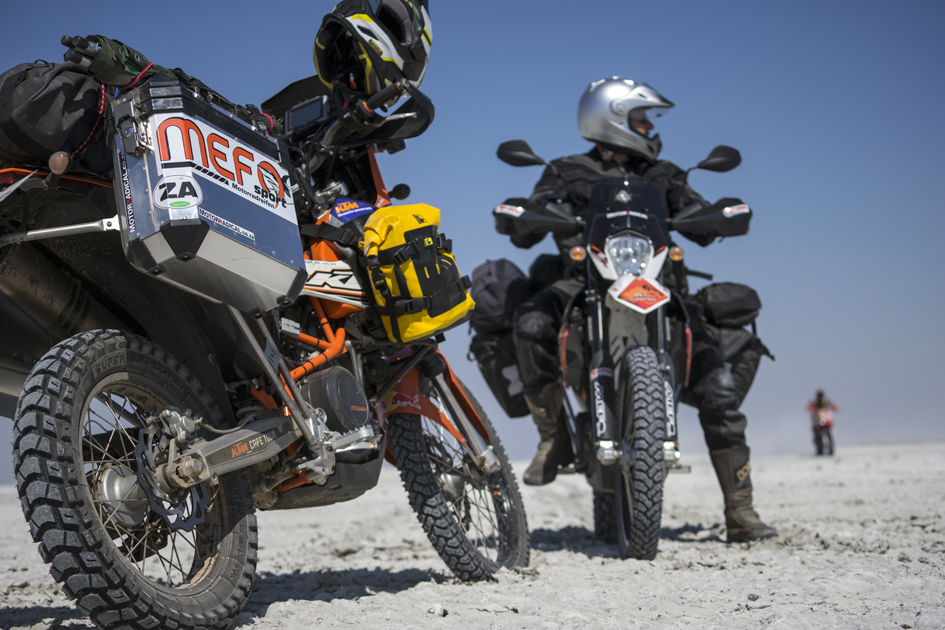
An early start from Pretoria helps us reach the African Ranch campsite before sunset. There, we set up camp on the Botswana bank of the Limpopo river. “That crocodile on that rock in the river will probably still be there tomorrow morning,” I think, “frozen stiff.”
Because after the sun goes down, the cold creeps in, enhanced by a wind from the east that disturbs the peace and tranquillity of our laager around the fire. It isn’t always hot in Africa.
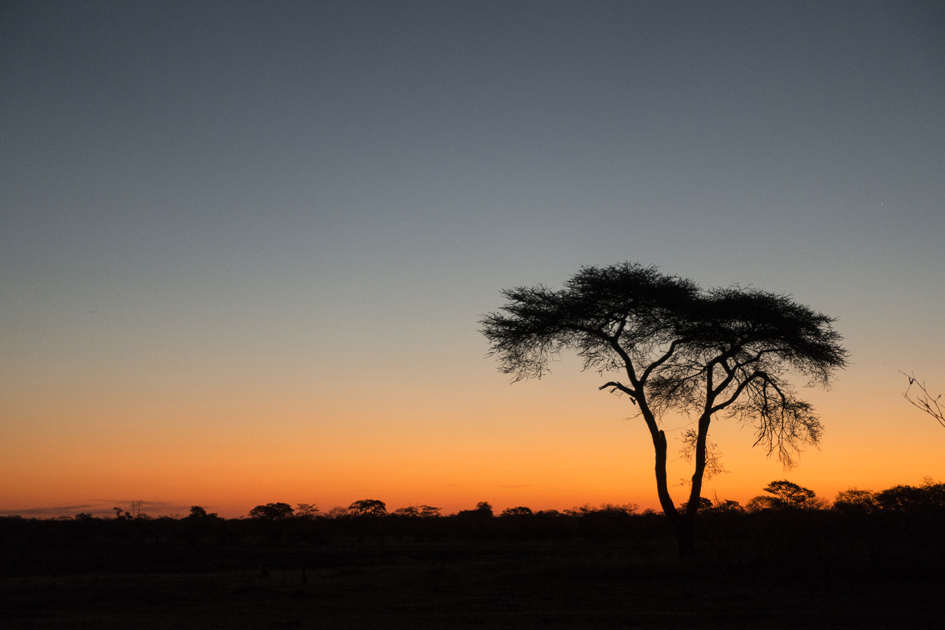
The campground is a new site, with very welcome amenities, such as a fireplace providing primaeval warmth, coffee and food, and a spotless ablution block. Yes sir: hot showers too, thanks to a donkey that feeds on wood and heats up the water in return.
Our suite is bigger than any president’s, with a majestic ceiling full of sparkling lights, supported by the broad branches of apple-leaf, leadwood, knobthorn, and jackalberry trees. I don’t know those trees; my South African riding buddy, Johan, tells me about them.
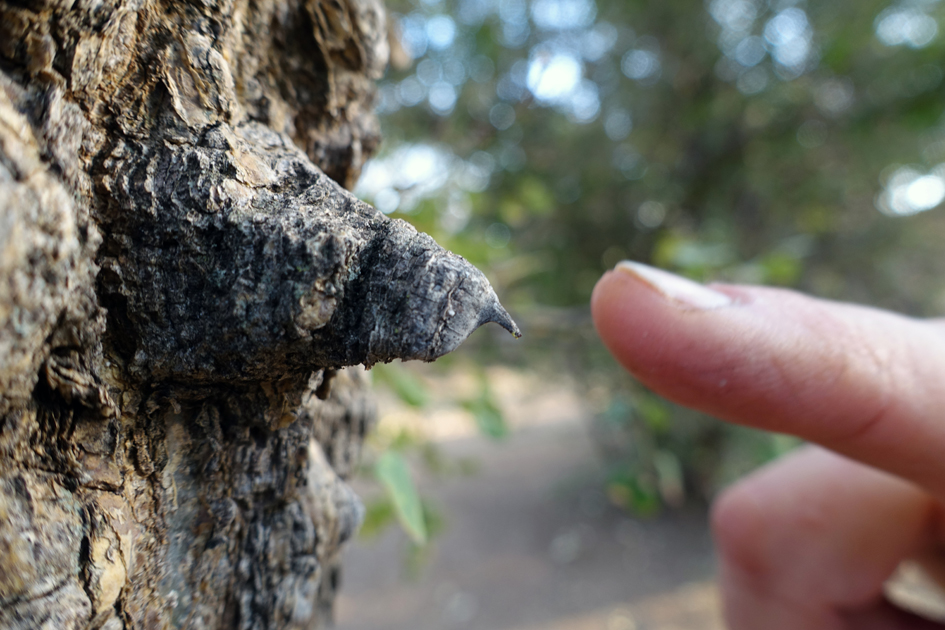
I am a rookie in Africa, whereas he grew up here and knows his way around, just like I can find my way home blindfolded in the Amsterdam Walletjies district on any given night. There is a lot to be learned in a short time—all the does and don’ts of riding in Africa, for instance, on and off tarmac. In Europe, I have to make an effort to find gravel experiences, while here, it’s the norm.
So how did I go about tackling the gravel road to African Ranch? Since Johan had disappeared in a cloud of dust, I was left to my own devices. Buying a KTM 690 Enduro and adding all the right accessories did not make me a dirt-bike rider overnight. Far from it, I hate to admit.
Swallowing dust and my pride, I tried to follow in Johan’s tracks. “If he didn’t fall off the bloody bike, neither will I,” I kept telling myself, grinding my teeth and sweating like a vlakvark caught in a bush fire in my protective vest, trying VERY hard NOT to come off the bike.
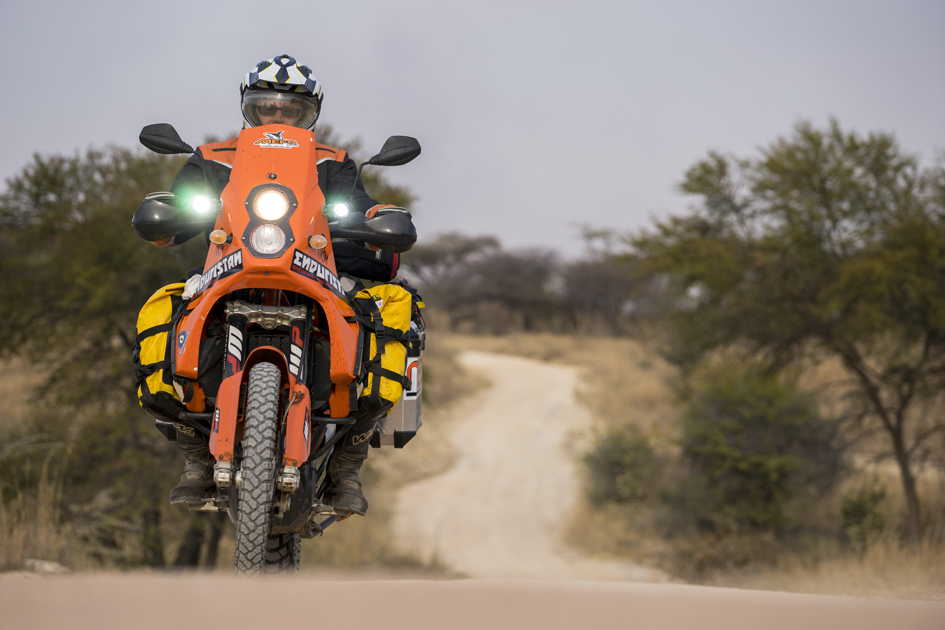
African Ranch signalled the very welcome end of the day’s ride, but not of the day’s lessons to be learned: “First thing is to keep away from the river banks—that mighty Limpopo is not your average European sweet water duck pond. We have crocs and hippos here, boet, things that bite and trample. And keep away from those branches. I told you so, now you know why this tree is called the draai-en-wag-’n-bietjie boom.”
After dinner we sit and sip at the fire, talking about our experiences on the first day. The pros and cons of my gear, like those bloody bags on my bike, with straps that keep loosening up along the road, forcing us to stop again and again and find another way of tightening them. I want my gear to be perfect and not give any trouble, while Johan takes a more philosophical approach and is ready for improvisations along the road as we go along.
Welcome to Africa, a rookie from Holland.
The birds are awake before I am. So is Johan. Already on the second day, on the road out of the urban jungle, some part of me wants to stay here at the Limpopo bank with the birds, the trees, and the croc, thawed by that splendid morning sun.
But another, stronger part of me dictates that we pack the gear, load up and start the bikes heading deeper into Botswana. Breaking up the tents is a breeze, they attach with just a few bungee cords to our bikes. And yet they didn’t pull our bikes down, these South African prototypes kindly loaned by their maker, Boer Schoeman, to the members of our expedition into the Heart of Africa.
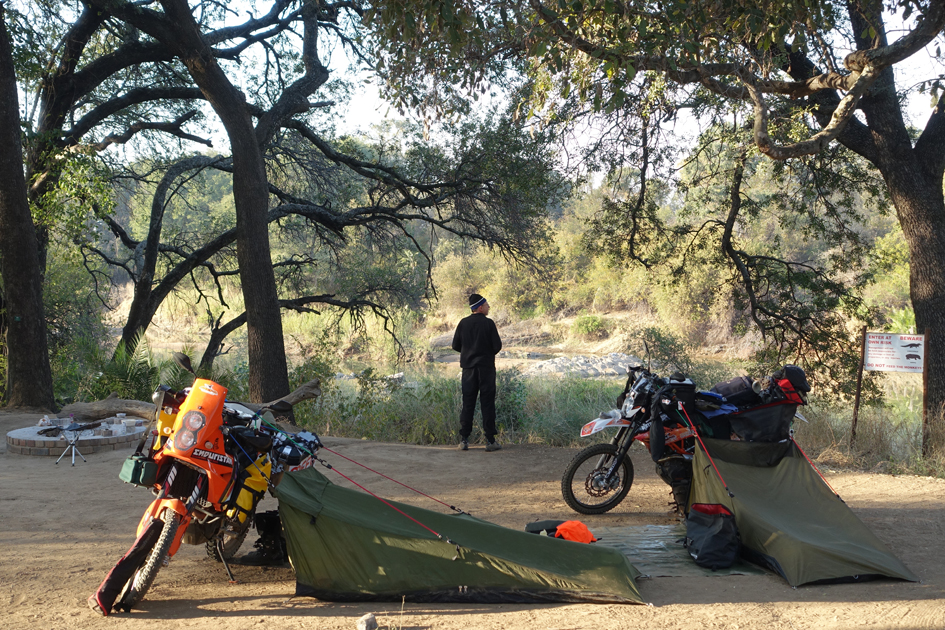
Yes, that’s a Livingstone quote on my tank bag: “Now that I am on the point of starting a trip into Africa I feel quite exhilarated. No doubt much toil is involved, and fatigue of which travellers in the more temperate climes can form but a faint conception.”
But first I need to handle these 30 km’s of dirt and dust again, on the way back to the Sherwood filling station, where the blessed black tarmac ribbon awaits. Those Mefo tyres are as good as their ‘Made in Germany’ stickers promise. I feel very secure on tarmac with them, and on dirt, it’s certainly not the tyres that set the limitations to my riding and sliding skills, if you catch my drift.
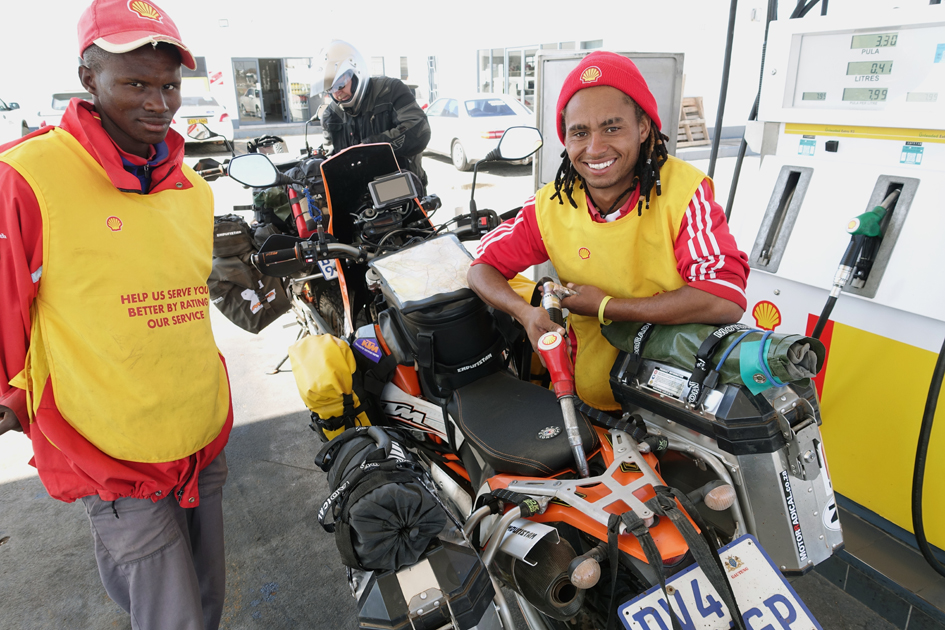
Between Limpopo and the Makgadikgadi Salt Pans there is not much interesting to see in the bush. The KTM’s hum along on the tarmac with the occasional dirt detour around road works.
Distances in Africa are much greater than in Europe. Between dots on the map there is nothing like a filling station, a restaurant or other infrastructure that lines the Autobahns of Europe—just thorn trees and anthills. Another long day in the saddle certainly puts strange ideas in my head.
And here we have Nata Lodge—a traveller’s den providing hot showers, cold beers and a place to pitch our tents. The local women serving us are full of laughter and jokes: “If you want to learn the Tswana language, you have to marry a Botswana lady. I am here!”
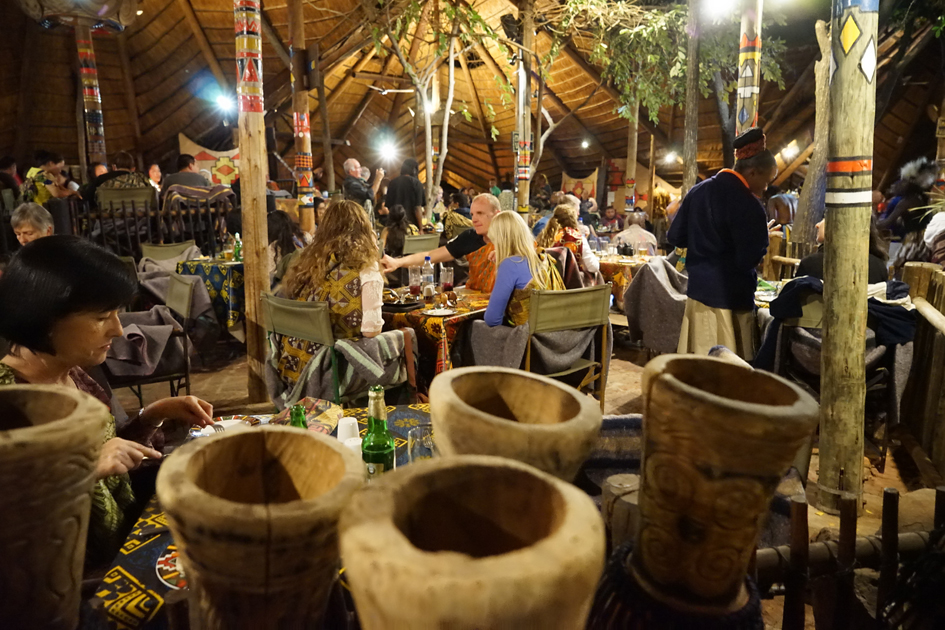
Before we get to the singing part, we meet up with Tunku, a Botswana businessman who has a nice collection of new and vintage bikes that he proudly shows us on his cell phone. And pictures of friends too, one of whom hit an elephant at around 200 clicks an hour on that nice Botswana tarmac road. (It was night and that road wasn’t as empty as it appeared to be.)
“Don’t even think of riding after sunset in Botswana,” is the lesson I learn here. And that puts an immediate end to lobola discussions, because if I can’t test a future bride on saddle steadiness and readiness, there is not going to be a marriage.
So I remain a lone rider on my KTM when we set out for the pans the next morning. I have the feeling that my riding skills improve on the Makgadikgadi underground—flatlands that extend far beyond the horizon with only an isolated island and a couple of motorcycles to break the monotony. But don’t get any funny ideas of signing up for the Dakar Rally yet, Dutchy!
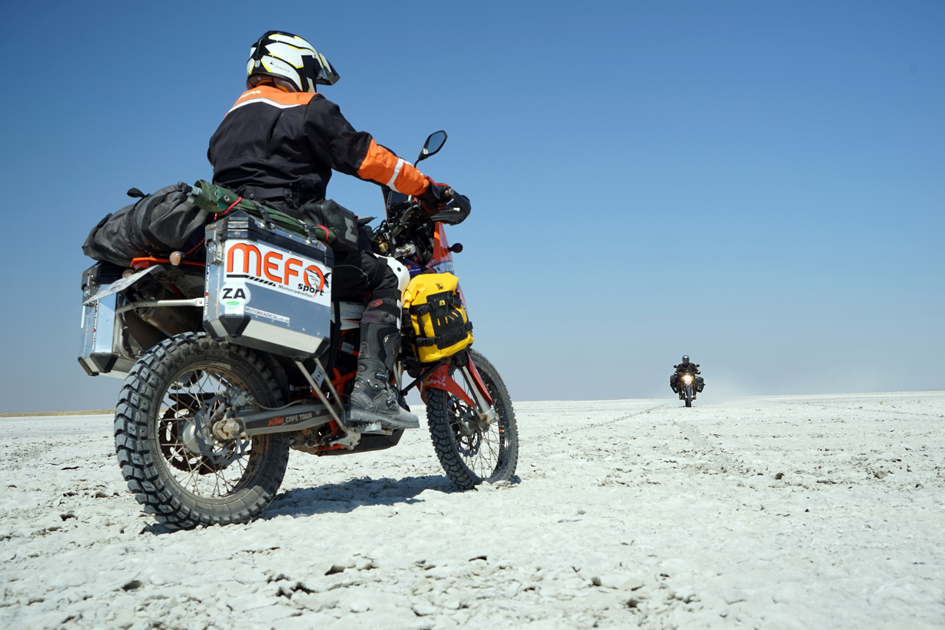
It’s only a few kilometres from the tarmac to our next destination. But those kilometres to Elephant Sands are deep, loose sand, and there are wild elephants around that do not abide by right of way rules, or any other European traffic etiquette. After being nearly trampled by a wild elephant in Mapungubwe National Park a week or so ago, I have developed deep distrust and disliking for these ungainly beasts.
So I am sweating and swearing in that sand trap, using both legs to prevent the bike from falling, and to help propel it forwards. The engine is whining and overheating, and all the time I have to watch out for elephants that try to blow me off my path. No: their path, strewn with smouldering heaps of their dung.
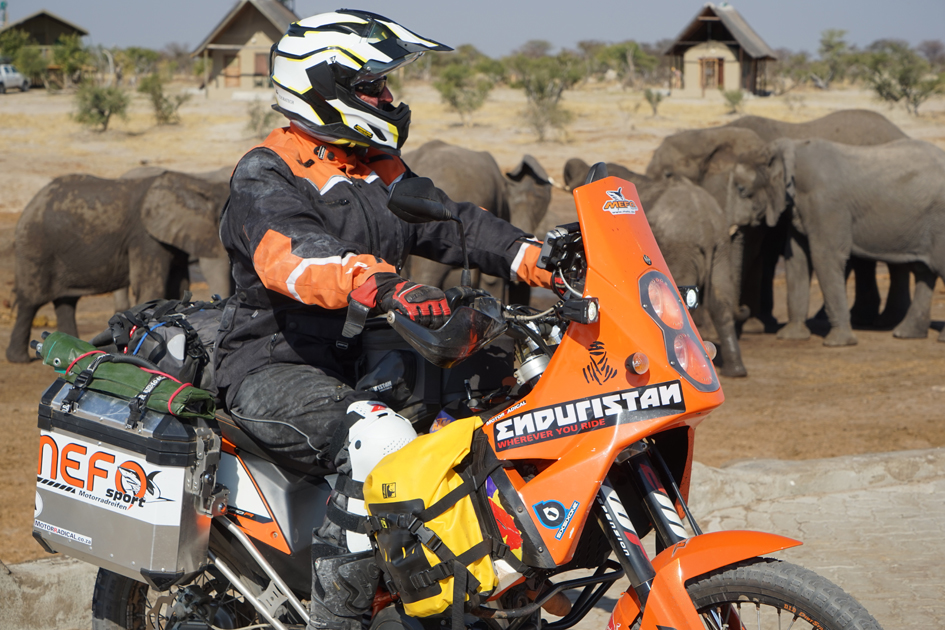
A humbling experience all right, one that is not easily washed away with just a hot shower at the lodge, where we put up our tents in anticipation of events to arrive. Like elephant bulls running up to the water hole for sundowners, and overland trucks discharging their cargo on the terrace overlooking the watering hole, swarming with elephants waving their trunks.
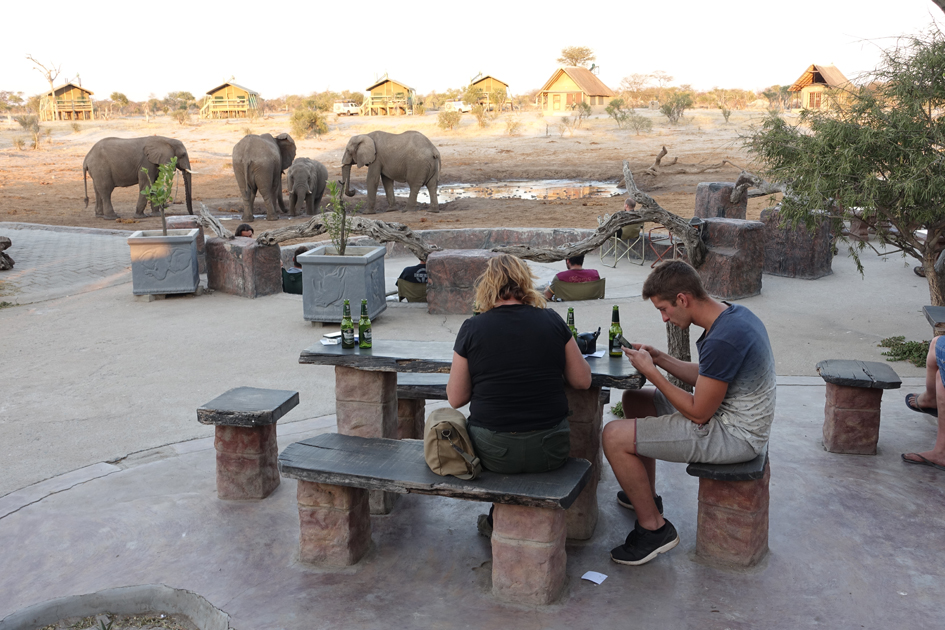
At one point, a bigger and stronger male pops in to dethrone his predecessor, just like the Italian off-road riders that came riding fast past me on top of the sand into the camp to dethrone their predecessor.
At sunset, it gets even more crowded at the water hole, as it gets crowded at the bar. Star show, campfire, comfortable chairs and cold beer… what more can a Dutchman on safari ask for? Exhilarated and exhausted, Johan and I retreat to our tents. With all my might I try to ignore the sudden scents and noises around my tent—how did that lullaby my mommy sang for me go again?
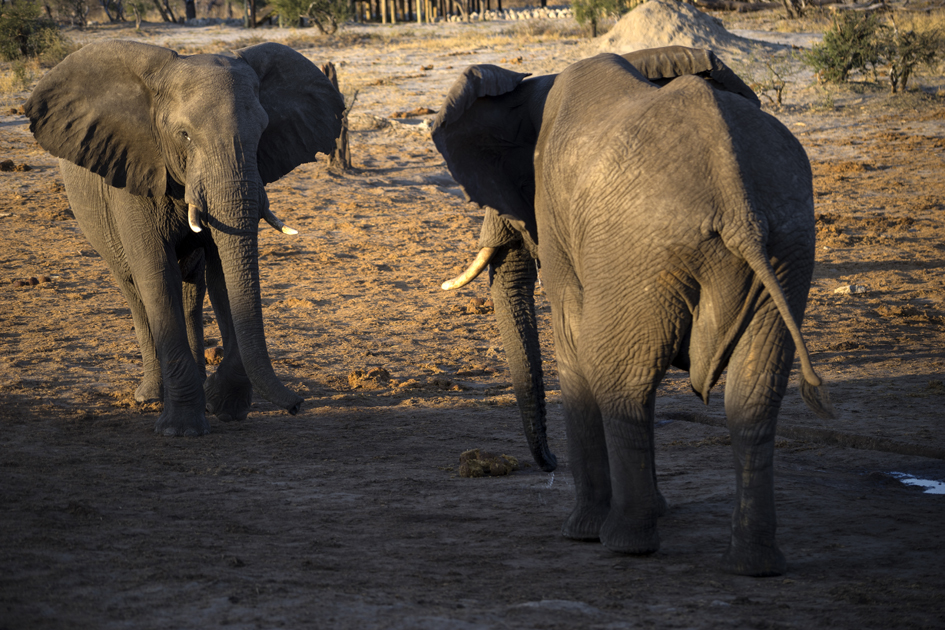
Johan’s voice sounds muffled: “Ehm, Michiel, I think my bike just fell over.” And because the tent is attached to the bike, he is trapped like a mummy in the fabric. I take a deep breath, carefully open the tent zipper and peer carefully around. No “Ellies” to be seen, but yes, Johan’s bike is down, as is his tent. Now, what on earth or beyond brought them down?
I free Johan from his tent and we put his bike and tent back up. A little later, and after much Zen-like effort to soothe my nerves, it’s Johan’s subdued voice again: “Ehm. Michiel, there is an elephant right next to our tents, I can see it clearly through my mosquito netting.” The flap over my mosquito netting is closed and I am going to keep it that way, no matter what—a paper-thin wall against the horrors of Africa.
Breakfast never tasted better.
Riding away from the lodge is much better than riding into it, knowing that I won’t have to do the same hellish ride again in reverse the next day. Plus the sand is still cold and provides more grip to the Mefos, and the owner of the lodge has assured this haggard looking Dutch guest that there are no elephants around this early in the day.
Back to the tarmac, that token of civilisation running north through the vastness of Africa. The size of Botswana and the distances remind me of Norway, also a country rich in minerals and natural beauty and with good infrastructure. Also pricey and set with crazy low-speed limits in the middle of nowhere. But Mother Africa teaches me to relax and enjoy the ride. What’s the hurry?
At the end of the road in Norway is the famous North Cape. At the end of our road in Botswana lies Chobe.
The Chobe river dams up because Zambezi’s flow is so strong that it is difficult for the Chobe waters to enter it, so there is a lot of water around. And where there is water, there are animals—plenty of animals, that we are seeing from the deck of a tourist boat steaming up and down that fine Chobe river. Elephants, yes, but also buffalo, hippo, croc, giraffe and all kinds of birds whose names I tend to forget as fast as Johan recites them.
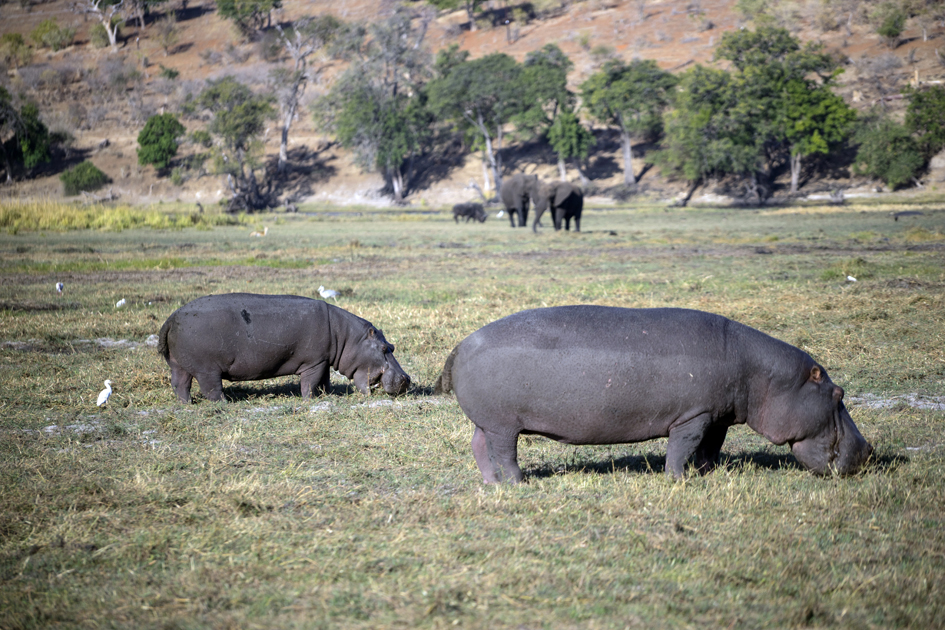
The next day we get an uninvited guest for breakfast—Meneer vlakvark has clearly set his mind on Johan’s muesli. We manage to send the scoundrel off, knorrend en piepend.
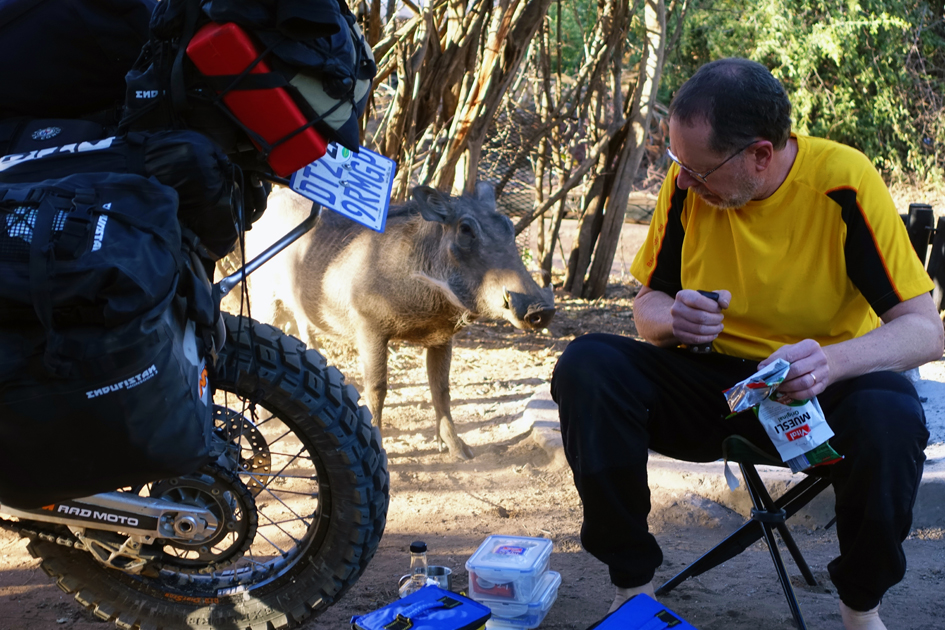
The officials at the Kazungulu border post into Zimbabwe are forthcoming and helpful. After the formalities, we ride through a landscape dotted with rolling hills towards Vic Falls. “Watch out for elephants on the road,” warns the policeman at our firsts roadblock in Zimbabwe. Certainly, a much stronger deterrent for speeding than any laser gun or speed bump can ever be.
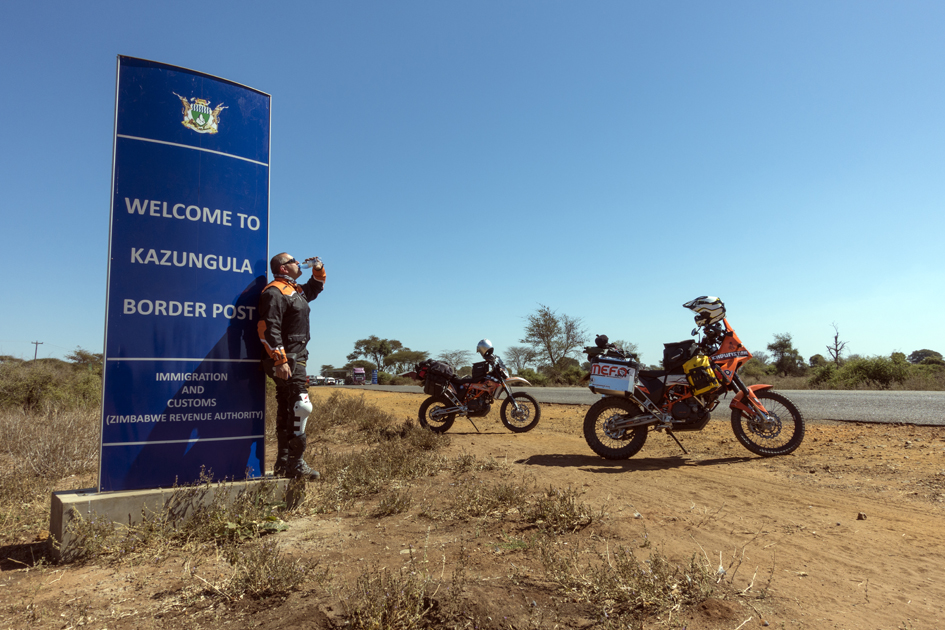
So now it’s time for the famous Vic Falls, Mosi-oa-Tunya: the Smoke that Thunders. “The most wonderful sight I have seen in Africa,” Livingstone noted in his diary. He saw the plummeting waters from above, crawling on a rocky outcrop in the Zambezi, protruding above the mighty waters falling down.
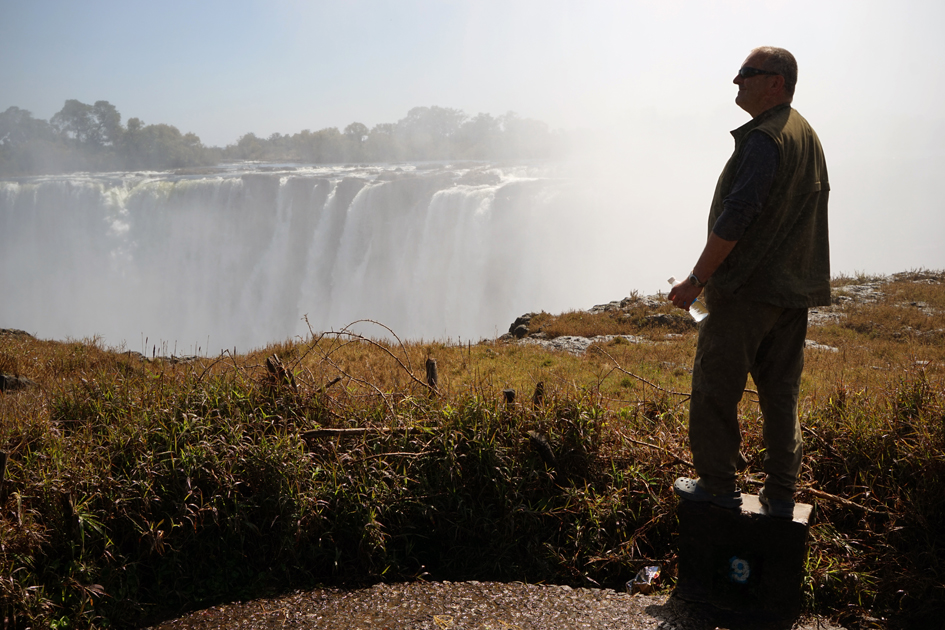
I pay a couple of too many US dollars for a helicopter ride to experience that frothy spectacle from above. And what a fine sight it is, both from the sky as from the lush forest opposite of the mighty walls of water. How can one put this into adequate words or images to take home?
For good luck, I buy a Nyami Nyami mascot at the local market, a small souvenir of the mighty river god that lives in the foaming waters. The tails of these amulets were traditionally made of elephants hairs, but now from Dunlop tyres. Progress indeed.
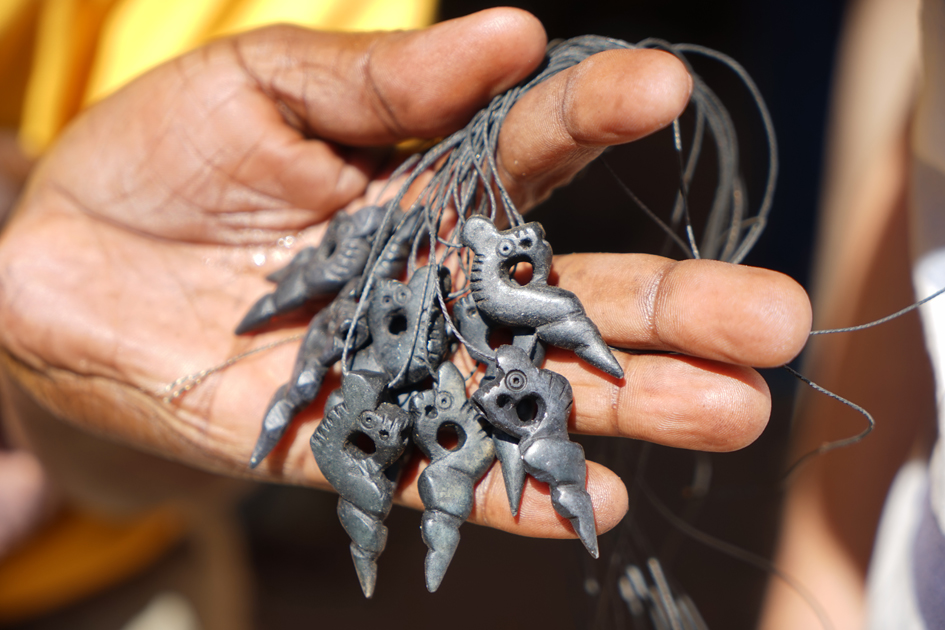
Nyami Nyami reportedly is angry, now that the mighty Kariba Dam prevents him from freely roaming up and down the Zambezi river. Any moment he can command the earth to tremble, the dam to break and the water to wash away everything that man has erected around the Thundering Smoke.
As a Dutchman, living about six meters under sea level, I know that uneasy feeling. And I am slowly getting used to persistent invasions of my comfort zone on this trip. People and animals come much closer, uncertainty and danger are sharpening senses that have been dulled by European life in comfort.
Slowly but surely I am shedding my rookie feathers and getting Africanised.
In the jungle, the mighty jungle, Johan snores tonight. But not even all that snoring, chortling and snorting outside my tent can keep me from falling sound asleep and dreaming of two KTM’s riding at full speed away from rolling waves of Zambezi water, on which the mighty Nyami Nyami surfs. The next morning the animals keep their distance when we’re having breakfast and packing up our gear again.
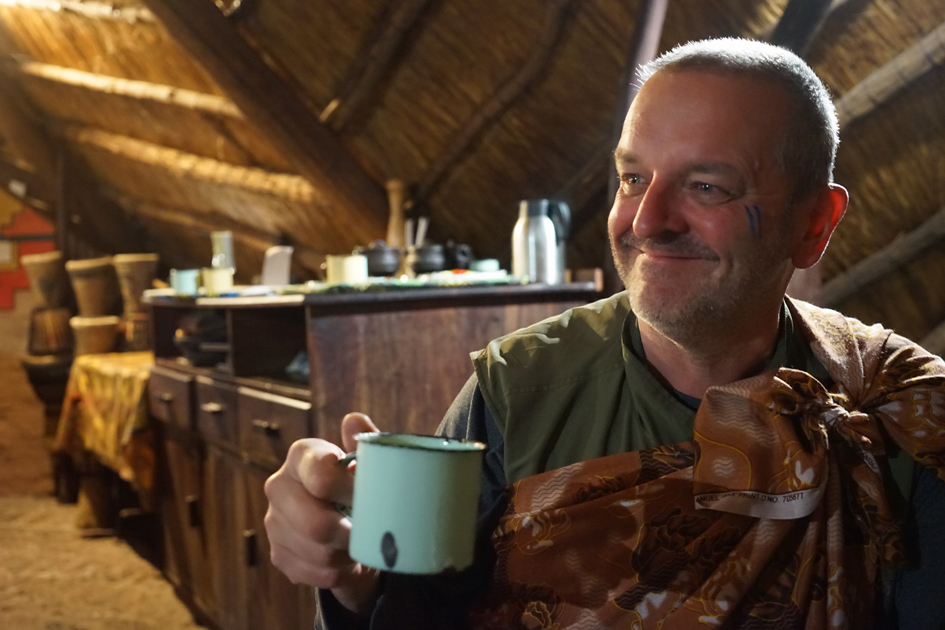
After Chobe and Vic Falls we leave the tourist magnets behind, and point our KTM’s towards the heartlands of Zimbabwe. What other obstacles will Africa throw in my way? What is there to be learned in the country that gets such different press than Botswana, reportedly full of corrupt policemen at roadblocks and wild animals that wander freely about?
Stay tuned for the next episode of ZAR Trek: the Rookie Ride into Zimbabwe.





